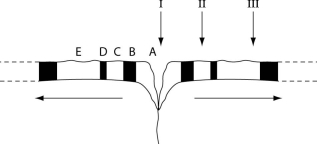Multiple Choice
The following questions refer to the description and figure below.
The figure represents a cross section of the sea floor through a mid-ocean rift valley, with alternating patches of black and white indicating sea floor with reversed magnetic polarities. At the arrow labeled "I" (the rift valley) , the igneous rock of the sea floor is so young that it can be accurately dated using carbon-14 dating. At the arrow labeled "III," however, the igneous rock is about 1 million years old, and potassium-40 dating is typically used to date such rocks. Note: The horizontal arrows indicate the direction of sea-floor spreading, away from the rift valley.

Figure 25.1
-Assuming that the rate of sea-floor spreading was constant during the 1-million-year period depicted above, what should be the approximate age of marine fossils found in undisturbed sedimentary rock immediately overlying the igneous rock at the arrow labeled "II"?
A) 10,000 years
B) 250,000 years
C) 400,000 years
D) 1,000,000 years
Correct Answer:

Verified
Correct Answer:
Verified
Q65: Which of the following factors weaken(s)the hypothesis
Q66: The following questions refer to the description
Q67: <img src="https://d2lvgg3v3hfg70.cloudfront.net/TB5463/.jpg" alt=" Figure 25.3
Q68: The following questions refer to the paragraph
Q69: What is true of the amino acids
Q70: Larval flies (maggots)express the Ubx gene in
Q71: One explanation for the evolution of insect
Q73: If one organ is an exaptation of
Q74: Several scientific laboratories across the globe are
Q75: The following questions refer to the paragraph